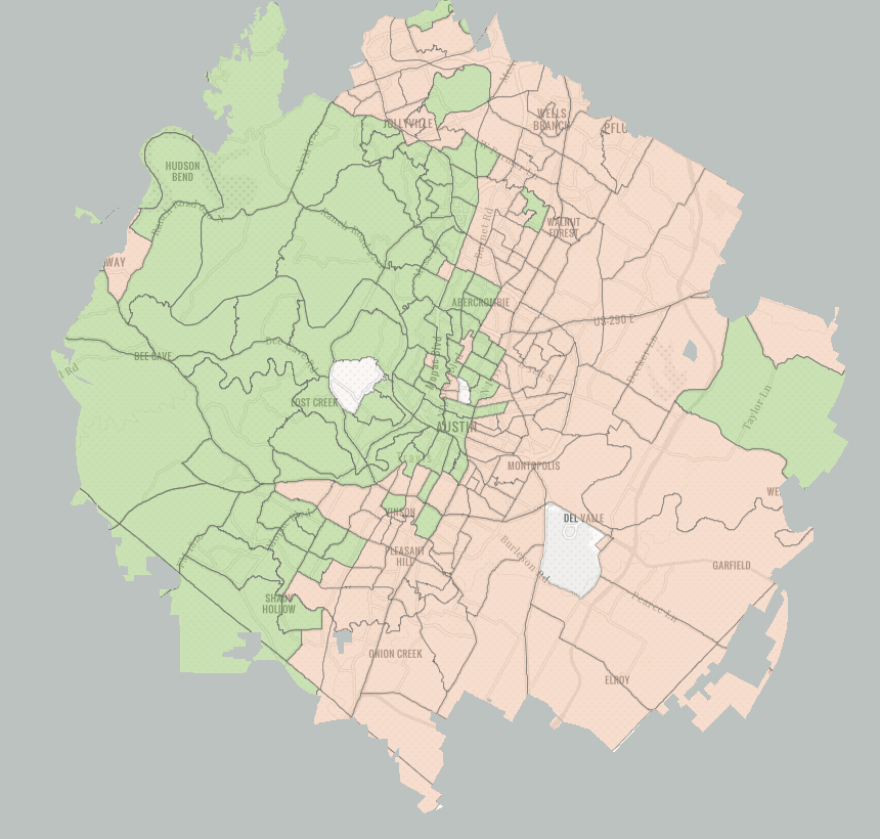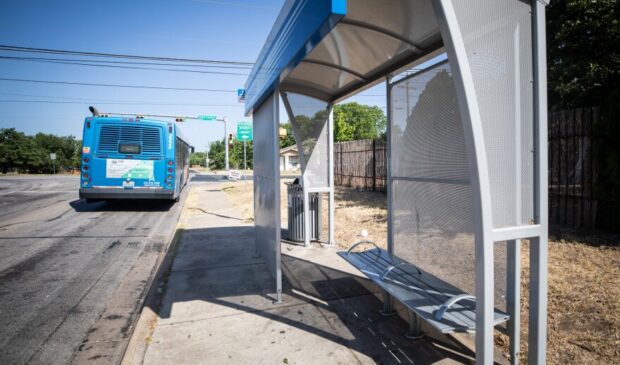Under Austin’s scorching afternoon sun, Elijah Archie finds himself at the outskirts of Capital Metro’s service area. He’s on Decker Lane, earbuds in, eyes scanning for the bus. He’s standing next to one of the public transit provider’s sleek, new silver bus shelters.
Archie wasn’t impressed with the shelter’s modern design. He didn’t really care about its lightweight aluminum build or how easy it was for Capital Metro to install. What concerned him was the size of the roof.
“They don’t got enough shade. Take ’em back!” he laughed, but only half-joking.
Last summer, Capital Metro’s board of directors greenlit up to $10.5 million for 562 shelters from California-based Tolar Manufacturing over the next five years. Just in time for a brutal summer heatwave, the first batch has been hitting the streets.
And riders are feeling the heat.
“I need shade,” Suzanna Galvan said while waiting at one of the new shelters on Stassney Lane in Southeast Austin. “I can’t handle the sun very well, and these don’t seem to cover much.”
The new bus shelters are smaller than the ones they’re replacing. Most are around 60 square feet, while the old shelters are closer to 100 square feet.

Photo by Michael Minasi/KUT. Most of the older shelters are either 7 feet by 14 feet (pictured above) with a 6-foot-wide bench or 10 feet by 10 feet with a circular bench. The roof on both structures is about 100 square feet, compared to a 60-square-foot roof on the most common replacement. The old structures don’t have vertical side panels that provide additional shade.
But Capital Metro is quick to defend the choice. It points out the new shelters have perforated side panels that offer extra protection from the weather.
“The biggest difference we’ve been able to add to the newer-style shelter is that it has vertical style elements that provide shade and not just the roof,” Capital Metro CEO Dottie Watkins told KUT.
Tolar’s shelters are easier to install. The old steel ones needed a fresh concrete base; the new ones can be bolted into pretty much any existing sidewalk. The new shelters are also easier to repair. Parts can be swapped out relatively easily, the company said.
The shelters are a lighter color to bounce off more heat. They have solar-powered lights that turn on when it gets dark. Plus, Capital Metro’s branding is easier to spot.
But perhaps the biggest selling point of the slimmer shelters is their versatility. They can fit in more locations than “the old steel behemoths.”
“Those (old ones) only fit in a certain number of spots, and a lot of places we didn’t have the right of way,” Watkins said.

Photo by Michael Minasi/KUT. Capital Metro’s newer 5-by-12-foot shelters can fit in places where the older ones could not.
A side-by-side comparison
Capital Metro has more than 2,300 bus stops. Less than a third – 761 stops – have at least one shelter, according to Capital Metro’s own data.
For years, Austin’s public transit agency has tried to put a shelter at any stop with at least 50 bus boardings a day – a standard practice among transit agencies.
Under that rule, only about 20 stops lacked shelters, mostly because of space limitations, Capital Metro staff said.
But the Capital Metro board changed the agency’s service standards last month to make it easier for stops to get a shelter. Now, bus stops where people have to wait longer will be prioritized, even if there are fewer than 15 boardings a day.
This change in policy and the new, more versatile structures mean at least 125 stops will get shelters. The rest of the new shelters will replace old ones that have seen better days.
Still, many riders said they prefer the older shelters and benches.
That message came through loud and clear last month when Watkins shared a side-by-side comparison of the old bus shelter and the new one on Twitter. The reaction was fast and fiery. The tweet was viewed more than 300,000 times, a staggering number given Watkins’ modest following of fewer than 700.
Our bus shelters are getting a new look. Keep an eye out as we work to deploy these new amenities in the coming months. Shelters help keep you safe, protect you from the elements and give you a place to sit. #tbt pic.twitter.com/xaCKDFSCxi
— Dottie Watkins (@CapMetroCEO) June 29, 2023
“We probably didn’t use the best pictures,” Watkins said. The comparison image showed the old shelter shaded in a nearby tree’s shade, while the new stop looked stark with the sun low on the horizon.
“Lesson learned. A picture’s worth a thousand words,” Watkins conceded.
But for regular Capital Metro user Jen Ramos, it wasn’t about the choice of images. Her long-simmering frustrations lay with the new shelters’ smaller size and lack of seat backs on the benches.
“What about people who have mobility issues? That’s an awkward angle,” Ramos said of the perforated panel behind the bench that can serve as a makeshift back rest. “It doesn’t make up for the lack of a back.”
Others, like Austinite Jen Wireman, expressed outrage over the middle armrest in the new benches, which prevents more than two people from sitting and makes the benches impossible to lie down on.
“Anti-homeless architecture,” Wireman labeled them. “The blatant use of it is when it comes to these public use benches.”
“It also seems pretty impractical, because you’re just assuming a certain size that everybody is. Some people are bigger,” she said.
Ramos went even further, calling the new benches “fat-phobic.”
Tree canopy
Neither Capital Metro nor Federal Transit Administration guidelines specify how big a canopy should be at a bus shelter. The city of Austin simply requires that the shelters should “protect against exposure to the elements as best as possible during peak demand periods.”
But for some Austinites, the shade of a nearby tree is more comforting than the city’s modern shelters.
Researchers like Kevin Lanza from UTHealth Houston have observed that shade from trees, not bus shelters, helps sustain ridership during the hottest months of the year.
“Bus stop shelters did not have a protective effect on ridership during extreme heat days,” Lanza said of his 2021 study analyzing Capital Metro bus boardings at each stop in the city. “Yet having nearby tree canopy around bus stops did have a modest protective effect on ridership levels when it was hot outside.”
Tree canopy covers about 36 percent of Austin, according to the city’s climate plan, but East Austin has much lower rates of tree canopy coverage.
“These trees are not in the neighborhoods where potentially there are the most folks who use the (bus),” Lanza said.
Austin hopes to achieve 50 percent citywide tree canopy cover by 2050, with a focus on areas that are most lacking in tree canopy.

Community Tree Preservation Division/City of Austin. This city of Austin map from 2020 identifies where trees should be planted on public land based on existing tree canopy and other factors, such as temperature and air pollution. Areas shaded pink are considered high priority for tree planting. Areas shaded green are low priority.
Capital Metro has considered planting more trees. But logistically, it’s difficult.
“The hardest thing about planting a tree is watering that tree,” Watkins said. “Because we’re installing our bus stops in the public right of way, we don’t have access really to the water service of that property.”
“Honestly, the best person to plant a tree toward the sidewalk is going to be whoever owns the land,” she added. “But we’re huge fans of trees.”
So, as Austin wilts under what is becoming its second-hottest July on record, Capital Metro’s new bus shelters are just one piece of a larger question: How will the city adapt to the intensifying Texas heat?






